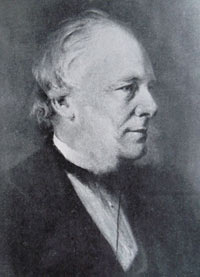THEY LIVED IN LEEDS
Dr Samuel Smiles (1812-1904)
Surgeon, Journalist, Reformer, Writer
 One evening in 1845 a group of young Leeds workmen, members of a ‘mutual improvement’ society, gathered in a dingy rented room to hear a talk by the editor of the radical Leeds Times, Dr Samuel Smiles, a passionate advocate of working-class education. He illustrated his inspirational talk with stories of famous men who from humble beginnings had achieved success and distinction through their own efforts and determination. So the seed was sown for the book that was later to make him a household name: the immensely popular Self-Help, published in 1859, constantly reprinted and translated into languages across the world over the following half-century.
One evening in 1845 a group of young Leeds workmen, members of a ‘mutual improvement’ society, gathered in a dingy rented room to hear a talk by the editor of the radical Leeds Times, Dr Samuel Smiles, a passionate advocate of working-class education. He illustrated his inspirational talk with stories of famous men who from humble beginnings had achieved success and distinction through their own efforts and determination. So the seed was sown for the book that was later to make him a household name: the immensely popular Self-Help, published in 1859, constantly reprinted and translated into languages across the world over the following half-century.
Samuel Smiles was a Scot, born at Haddington near Edinburgh in 1812, one of eleven children of strict Calvinist parents. At fourteen he was apprenticed to the local doctor, and later gained qualifications in medicine and surgery at Edinburgh University. He returned home but found few patients, so began to write articles on the social issues close to his heart – journalism beckoned as a possible alternative career. In 1838 he was offered the editorship of the reformist paper, the Leeds Times. He accepted, hoping to promote his ideals of a more just society. He was to spend the next twenty years in Leeds, where he married and his five children were born – ‘about the happiest and most fruitful period of my life’.
The 1840s in Leeds were years of political unrest and economic hardship. Smiles was a passionate supporter of reform, pushing for electoral change, the repeal of the Corn Laws, working class education and research into unemployment and poverty. He wrote numerous editorials, he gave lectures, he took a leading part in the Leeds Parliamentary Reform Association and was active in a grass-roots committee investigating unemployment. He believed in reform through rational negotiation and consensus, and was deeply opposed to the violence of the Chartists, but in time he began to feel frustrated and disillusioned by the failure of this approach.
In 1845 he resigned from the Leeds Times, but had to find work to support his growing family. After a brief return to medical practice, he was appointed Secretary to the newly-planned Leeds and Thirsk Railway. It was no sinecure. Work began on the line to Harrogate in 1846, but met with desperate problems in constructing the long Bramhope Tunnel, bedevilled by constant flooding and subsidence. The cost in money and life was crippling – twenty-four men died building the tunnel (their memorial still stands in Otley churchyard) and the company was almost bankrupted. The line finally opened in 1849.
Meanwhile Samuel Smiles and his family had moved from town to the more rural surroundings of Woodhouse Cliff. Alongside his stressful work, he continued to write and lecture. He campaigned for a national education system and for public libraries, and found time to support local initiatives – he was the first president of the Woodhouse Mechanics Institution and taught at the Zion School at Wortley. But in 1854, when the Leeds and Thirsk Railway was absorbed into the Leeds Northern, he lost his job and moved away to London, to become Secretary of the South Eastern Railway company.
Over the next years he filled his evenings and spare moments with writing. His first book was the Life of George Stephenson (1857), its success prompting his publishers to go ahead with Self Help which instantly became an international bestseller (they had previously rejected it!) This was followed by Lives of the Engineers (1862) and three further books expounding his social philosophy: Character (1871), Thrift (1875) and finally Duty (1887). The titles speak for themselves.
The double pressure of writing and working affected his health; he retired in 1871, but lived on, still writing, until 1904. By then the popularity of Self-Help and the social vision it embodied was waning. Later critics condemned Smiles as moralising and patronising, promoting a myth of individual social mobility, but his work continues to attract comment and reinterpretation. The ideas discussed in the dingy room in Leeds in 1845 are not forgotten, and in their time provided his listeners with encouragement and hope.
Eveleigh Bradford
May 2012